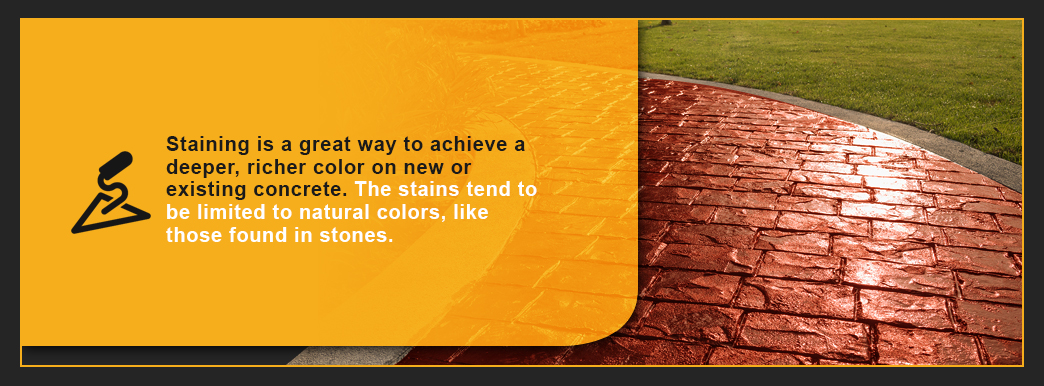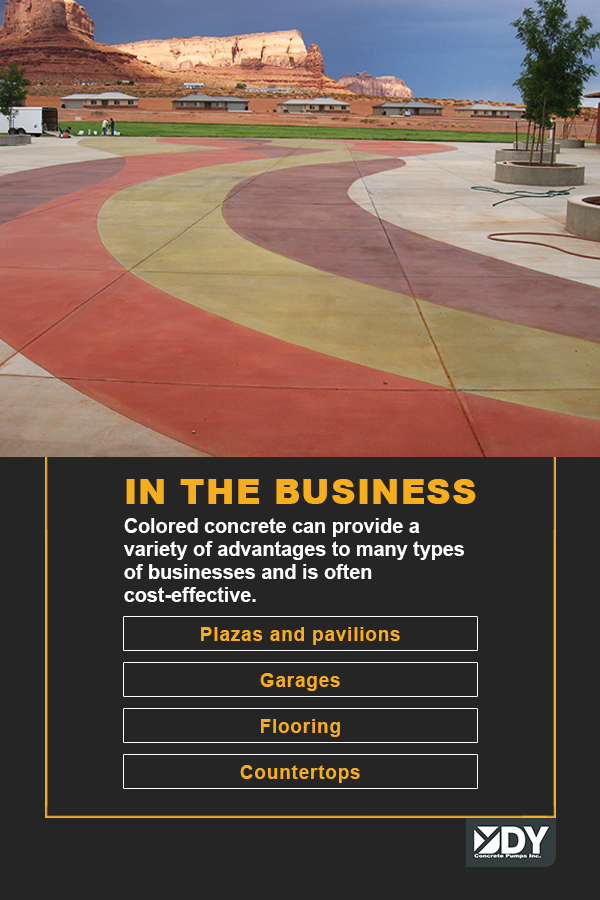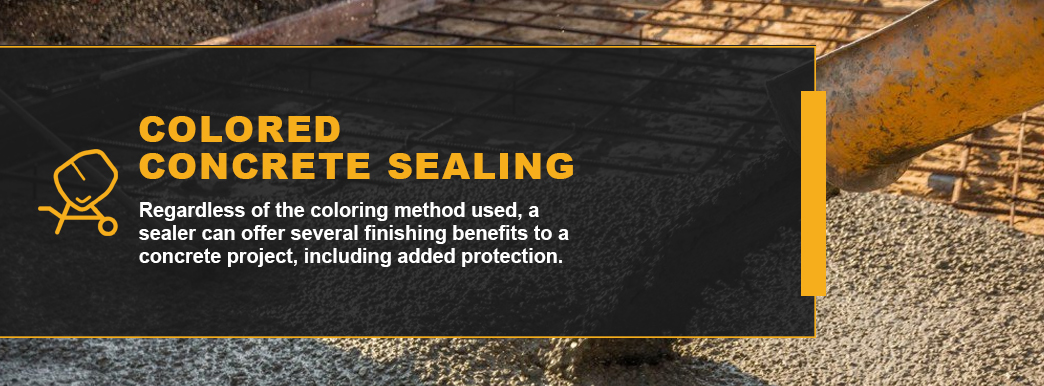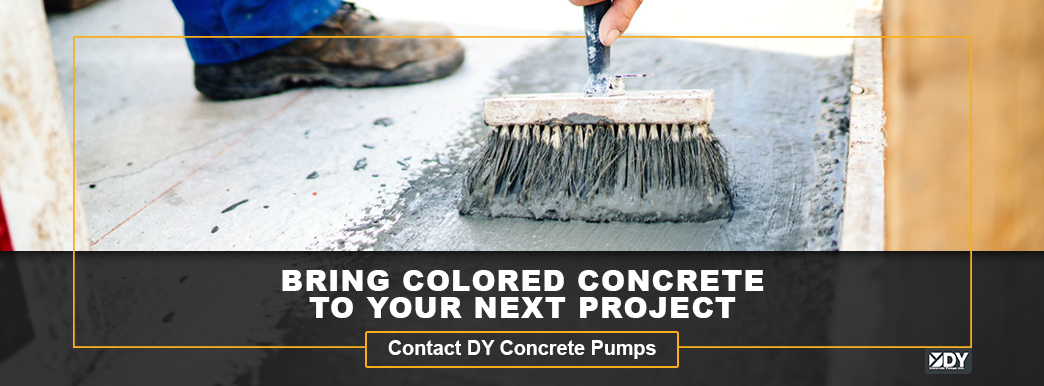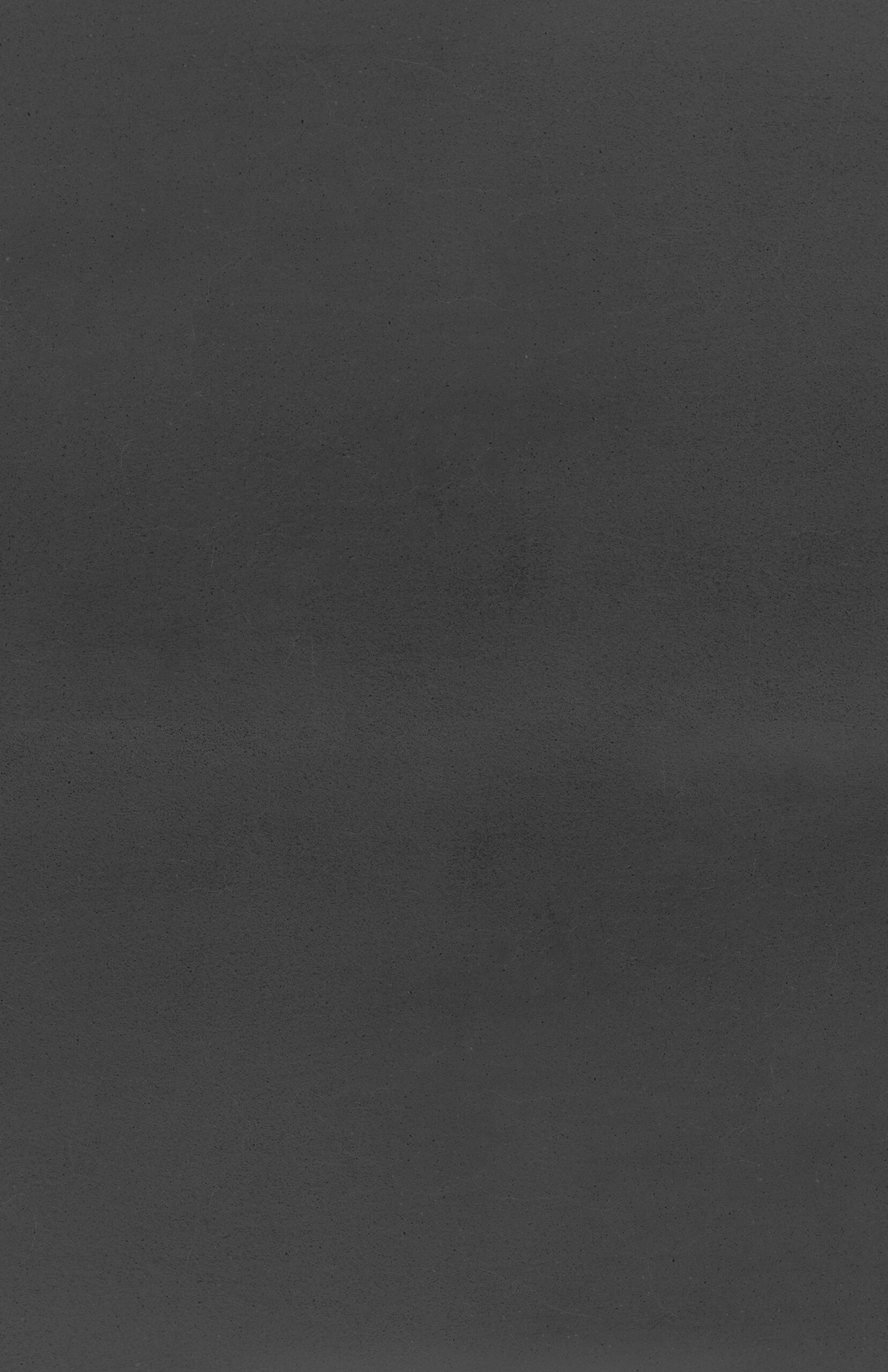
Guide to Colored Concrete
Posted By:Dynamic Concrete Pumping , Date: Jun 6, 2020
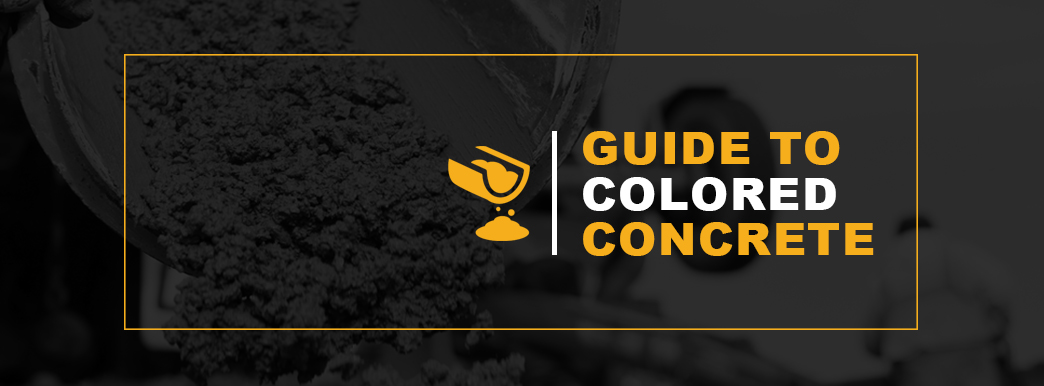
If you’ve ever been on a large, beautiful plaza or a unique-looking crosswalk, chances are you’ve stepped on colored concrete. While it used to be rare, colored concrete is moving up in the world as businesses and homeowners alike are learning how versatile it can be. Patios, garage and basement floors, roads and countertops can all be made using a colored concrete mixture.
The process is achieved through a variety of methods and utilizes different types of sealer. The options that colored concrete designs offer are nearly endless. Read on to learn about what is in a colored concrete mixture, colored concrete sealers, their costs and their applications.
What Is Colored Concrete and How Is It Made?
Colored concrete adds excitement to any project. Concrete is already a popular building material, due to its durability, versatility and affordability. In the United States alone, annual cement sales are valued at about $12.5 billion. Cement has retained its popularity throughout the years and has now taken on a new form.
Iron oxides have been used as dyes since pre-historic times, and modern concrete continues this tradition. These chemical compounds are commonly used to add natural, earthy colors to concrete. New processes have allowed for more consistent, synthetic oxides to serve as pigments, but the effect is similar.
There are several different methods of how to color concrete, each of which comes with its own benefits and drawbacks.
1. Integral Coloring
This method infuses the color with the cement mixture, meaning you can only use it as the concrete is being poured and can’t apply it to existing slabs. It works by adding pigment to the mixture before placing it. These pigments come in liquid, granular and powdered forms and are frequently found in earth tones. These colors allow for concrete that blends well with nature. An earthy reddish color looks more natural in a lush backyard than the utilitarian gray of standard concrete.
Another benefit of integrally colored concrete is its composition. Since the color goes all the way through, it can’t wear down, chip away or fade. This aspect makes it great on its own or as a base for other coloring options like stains and hardeners. It can also be used to create stone or brick look-alikes.
2. Staining
Staining is a great way to achieve a deeper, richer color on new or existing concrete. The stains tend to be limited to natural colors, like those found in stones. The stains are acid-based and react chemically with the concrete. This reaction gives the concrete a mottled look and means that the acid needs to be neutralized after application. The concrete must be rinsed thoroughly before adding a sealant, which can make this process take longer.
The nature of stains means that they penetrate the surface of the concrete and are semi-transparent, so they won’t cover up any existing problems. Stains are UV-stable, meaning they won’t fade when placed in sunlight.
3. Color Hardeners
Color hardeners are an option for both natural and less earthy shades. It comes in the form of a powder that is made up of a mix of pigments, fine-grade silica sand, wetting agents and portland cement. This powder is shaken over fresh concrete and then spread over it. Hardeners are commonly used for stamped concrete because the imprints show up better and can include more variations in tone. They can also make the concrete more resistant to wear, deicing chemicals and moisture. This stronger surface is more durable and makes color hardeners an excellent option for outdoor applications.
The biggest downside to color hardeners is the application process. The wind may pick up the powder, which will stick to any structures or vegetation nearby. Indoor applications can also be messy and can pose breathing problems for anyone nearby. Because of this, you need to take safety precautions when working with color hardeners and, only experts should apply it.
4. Dyes
If you’re looking for the most vibrant color possible, dyes are the way to go. You can branch out from the natural and get colors like purple and blue if desired. Common uses include creating patterns and graphics.
Dyes are applied over the top of existing concrete using a sprayer, brush or sponge. They are often acetone- or water-based stains that mix with water or a solvent. Once mixed and applied, the color penetrates the concrete. Applying more than one layer can create an especially vibrant surface, but you can also mix multiple colors for a unique result.
One downside to dyes is that they are more likely to fade in the sun. Some are more UV-stable than others, and you can potentially use a sealer to protect dyed concrete if placing it outside. Some dyes even have sealer built in that can do double-duty. There are many variables to a dye’s fade-resistance, so it helps to check with the manufacturer and contractor.
Common Applications for Colored Concrete
You can find colored concrete in a variety of places, including homes, business buildings and outdoor areas.
1. In the Yard
In the great outdoors, colored concrete is a great way to bring natural shades to a yard. Concrete that mimics stone can easily blend well with landscaping designs.
- Patios: Concrete patios have been around for a while, but many are made with the standard gray. Colored concrete can add unique patterns and stamps or make it blend better with the house and yard. A stamped patio with blocks of dark gray and reddish-orange could work with a variety of furniture options. In a yard full of greenery and twinkling lights, a deep, rich brown color would add some charm in both night and day and look perfect at gatherings or cookouts.
- Sidewalks: Make the entryway sparkle with a beautiful and durable leadup to the front door. These can wind through a yard and be customized to match their surroundings, whether that is the house itself, a garden or decor.
- Pool decks: Colored concrete is also popular on pool decks, especially when it is stamped to look like natural stone. It helps to create the feeling that the pool was carved right out of the ground.
2. In the Business
Colored concrete can provide a variety of advantages to many types of businesses and is often cost-effective.
- Plazas and pavilions: One noticeable change would be to fix up a plaza or entryway. Colored concrete makes this area into something unique that can stand up to high traffic and be an attractive sight for visitors. These areas must adhere to certain requirements about accessibility, which can limit the use of odd textures and materials. Concrete is wonderfully simple, and adding color can create visual interest while maintaining its practicality.
- Garages: Detailers, repair shops, showrooms and any place that works with vehicles can benefit from a colored concrete floor that protects against liquid spills and tire marks. It also adds a classy, inviting appearance to an industrial environment.
- Flooring: Lobbies and cafeterias are great locations for colored concrete, as they are high traffic areas and should feel welcoming. The durability and visual appeal of colored concrete make it ideal for this type of application.
- Countertops: Concrete countertops and sinks are increasingly common. They are relatively cheap and color can make them fit well in any existing design scheme.
3. In the City
Governments can also benefit from colored concrete by using it for beautification efforts. Adding natural tones can make a city more appealing and give it a certain charm that standard concrete simply can’t offer.
- Sidewalks and crosswalks: A delightful splash of color can give a city’s sidewalks and crosswalks a unique look that gets the attention of locals and visitors alike. San Francisco, for example, is known for the rainbow crosswalks in its Castro neighborhood, and Seattle encourages its residents to watch out for different shades of red under their feet. Consistent color throughout a city can help to create a theme.
- Dividers: Using colored concrete for roadside barriers is another way to support beautification efforts. While these still need to be highly visible, colored dividers can make the drive more scenic. A rustic brown bordering the highway provides a better match to trees or cliffsides. For more high-risk areas, contrasting colors can enhance safety by making barriers more easily visible.
- Medians: Driving safely requires visible roads and signals. By making medians out of vibrant colored cement, cities can avoid maintenance costs associated with frequent repainting. This goes for crosswalks, too. Colored cement is much more durable than paint and, depending on the method used, can be resistant to the intense wear that traffic structures see over the years.
- Roads: Entire roads can be paved with concrete. Stamped concrete can make a road out of rustic “stone” or bright “bricks.” Plus, lighter colors can reduce the heat island effect that sometimes plagues large cities. The heat island effect refers to the rise in temperature that occurs around urban areas due to human activity. Light-colored concrete reflects much more sunlight than asphalt and can significantly reduce heat and associated energy costs when used as pavement.
4. In the Home
While a residential home might not be the first place you picture concrete, it’s an excellent option.
- Flooring: Any area of a home that requires concrete flooring can benefit from color. The use of colored concrete allows for crisscrossing patterns and unique molds. Creativity can flourish in home flooring, and it makes for an eye-catching addition to any room. Concrete floors are popular in basements, and colors allow for a more finished appearance without eliminating the durability that you may want there.
- Garage: Garage flooring is commonly made of concrete, and one can easily add color for a variety of effects to bring a touch of class to the garage. The mottled effect from stains can give a natural feel, and integrally colored concrete offers a wear-free option that can stand up to any dropped tools or spills. Different color and sealer options may offer more valuable benefits based on how the garage is used.
- Countertops: Concrete countertops can be very durable and feature exciting effects. Color can make them much more appealing and add a homey touch to an industrial-feeling material.
- Sinks: Concrete sinks are useful features in bathrooms, kitchens, garages and other rooms of the house, but a stark gray sink can be a little bland. Warm tones lighten up a room and can keep the bathroom bright.
- Furniture: You can even make furniture, such as dining tables and benches, out of concrete. Coloring it gives you more flexibility and makes this decor option more versatile.
Colored Concrete Sealing
Regardless of the coloring method used, a sealer can offer several finishing benefits to a concrete project, including added protection. Some of the things a sealer can protect against include:
- liquid stains, such as those from fuels and chemicals
- deicing salts
- yellowing
- water damage
- scuffs and heat
Sealers may be tinted or clear, and clear seals can be tinted on-site. The opacity varies depending on your application, and it may take more than one coat to get the desired coverage. You must wait to apply a sealer until after the concrete cures fully, which can take several weeks. Putting a seal on uncured concrete can cause a milky haze to appear in the layer of sealer. This haze is a result of the sealer’s reaction to moisture.
Other jobs that a sealer performs include:
- Hiding inconsistent colors: If a project’s gone wrong, a seal tinted to the same or similar color as the concrete can help cover up blotches or uneven color. This goal may take several coats at higher opacities to achieve but maintains a smoother finish, which is particularly useful for large slabs.
- Adding slip-resistance: Some applications will need a slip-resistant surface, and a sealer can do just that.
- Making maintenance simple: Washing a concrete surface with soap and water is usually enough to wipe away any dirt and grime that builds up, and the concrete itself tends to be long-lasting.
- Preventing scuffs and damage: High-traffic areas are hotspots for scuffs and dents on the floor. A sealer that protects against this damage can be a game-changer for an indoor space.
- Providing breathability: When moisture becomes trapped underneath a sealer, it can cause damage as it reacts to temperature changes in the environment. Repeated freezing and thawing can lead to trouble if the concrete is not sealed with something breathable. When a sealer is breathable, it allows the liquid to move through it, preventing it from getting trapped underneath and ruining the concrete.
- Creating the perfect finish: Sealers can be matte, glossy or anywhere in between. These sheens can be vital to bringing someone’s vision to life. They provide much more variety to the ways in which one can use concrete.
Bring Colored Concrete to Your Next Project
The materials you use in your next project will determine its quality for years to come. Colored concrete offers benefits that range from aesthetics to strength to durability. It works for any number of residential or commercial applications and isn’t difficult to implement.
Whether you opt for standard or colored concrete, you’ll want to have the concrete pumping and placing done by an expert concrete contractor. If you’re located in Alberta or the surrounding area, Dynamic Concrete Pumping is ready to assist you with all of your concrete needs. Contact us today to discuss your next concrete project.


